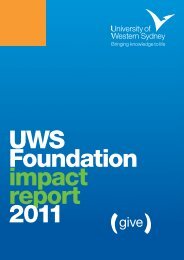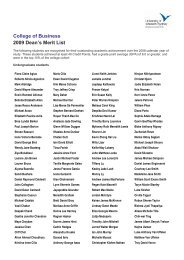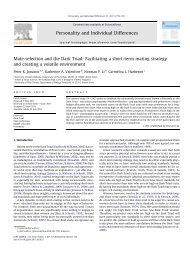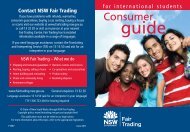Resume Review Checklist for Students:
Resume Review Checklist for Students:
Resume Review Checklist for Students:
Create successful ePaper yourself
Turn your PDF publications into a flip-book with our unique Google optimized e-Paper software.
UWS Careers & Cooperative Education<br />
<strong>Resume</strong> <strong>Review</strong> <strong>Checklist</strong> <strong>for</strong> <strong>Students</strong>:<br />
Overall Presentation<br />
Presentation<br />
Format<br />
Sequence<br />
Length<br />
Language<br />
Individualised<br />
Detail<br />
Questions to ask<br />
yourself<br />
Leaves a positive overall impression, no negative words or phrases<br />
Uses 10-12 size text<br />
Headings stand out – 2 sizes larger than normal text and bold<br />
Provides adequate space between sections of in<strong>for</strong>mation<br />
Left-hand margin about 3 cm wide<br />
Sections of in<strong>for</strong>mation not split across 2 pages<br />
No use of gimmicks eg coloured paper, fancy borders<br />
Consistent <strong>for</strong>matting throughout – font, size, justification, position of headings<br />
Uses sub-headings to make relevant points easy to find<br />
Limits use of highlighting techniques – no uppercase, underlining and multiple fonts<br />
Uses tables to categorise and list technical or IT experience<br />
Name and page numbers included in footer of each page<br />
Most recent in<strong>for</strong>mation listed first, then working backwards chronologically<br />
Order of headings lists the most important in<strong>for</strong>mation first<br />
Position requirements are addressed closely – using evidence and examples<br />
All dates are correct (using months and years only) and any gaps are explained<br />
Graduate resume is 2-3 pages<br />
Professional resume is 3-4pages<br />
Uses a combination of brief text and bullet points – no wordy paragraphs<br />
Uses <strong>for</strong>mal business language –is clear, concise and relevant<br />
Only uses words with which you are familiar<br />
Correct grammar and punctuation throughout<br />
Correct spelling – English (Australian not US)<br />
Avoids overly specific professional jargon and unexplained abbreviations<br />
No unnecessary words or punctuation<br />
Bullet points begin with active verbs (e.g. manage, report, develop, coordinate)<br />
Consistent tense used throughout (current tense <strong>for</strong> current job, past tense <strong>for</strong> previous jobs)<br />
No repetition of in<strong>for</strong>mation – draws on a broad range of examples<br />
Numbers expressed in written <strong>for</strong>m between one and nine (eg one, five, seven), and in<br />
numerals <strong>for</strong> all numbers 10 and above (eg 10, 25, 108).<br />
Ensures consistent date <strong>for</strong>mats throughout<br />
No use of the pronoun "I"<br />
Shows enthusiasm! Will make the employer to sit up and take notice. Energy and excitement<br />
are contagious<br />
Stands out favourably from the crowd by providing relevant, factual and current in<strong>for</strong>mation<br />
about education, skills and experience<br />
Uses relevant key words that will appropriately key word-sort your resume<br />
Lists appropriate detail and in<strong>for</strong>mation to support your claim to the position<br />
Meaning is clear<br />
All gaps in dates explained<br />
Targets the specific job you are applying <strong>for</strong><br />
Not too much detail. Employers want relevant in<strong>for</strong>mation, but they are not especially<br />
concerned if you opened the mail or filed personnel records<br />
Compare your resume with the job description, have you shown you have developed the<br />
skills the job needs?<br />
Remember that your resume should give evidence, by highlighting what you have done in<br />
the past, and that you have the skills to carry out the job to which you are applying.<br />
It is neat, tidy, and professional?<br />
Is it clear, logical and is in<strong>for</strong>mation easy to find?<br />
Have you asked <strong>for</strong> a second opinion (it’s a good idea to have someone proof read your<br />
resume <strong>for</strong> any obvious mistakes and give you some constructive feedback).<br />
Remember your resume will need a covering letter to go with it, and a claim <strong>for</strong> the position<br />
addressing all of the selection criteria one by one.<br />
Have you told the truth? Present your accomplishments and skills in the best possible light<br />
but ensure you’re not stretching the truth<br />
Have you got copies of this resume <strong>for</strong> reference?
Specific Content<br />
Name and<br />
Contact Details<br />
Career<br />
Objective<br />
(optional)<br />
Education<br />
Skills Summary<br />
Employment<br />
Professional<br />
Development<br />
Professional<br />
Membership/s<br />
Interests<br />
Your name is the heading of the document (large, centred, bold)<br />
‘<strong>Resume</strong> of’ or ‘Curriculum Vitae of’ not included, nor is a cover page<br />
Sub-headings of Name, Address, Telephone not included – these are self-evident<br />
E-mail address is professional (no more ‘hotchickybabe@wotsnew.com)<br />
Date of birth, age, health, religion or marital status not listed<br />
Citizenship/Visa status listed (when appropriate) toward the end of the resume<br />
Address and phone number current and correct<br />
Shows clear,concise and brief, factual sentences using a maximum of 3-4 lines<br />
Starts with your current situation eg Recent Business graduate, or Community Welfare student<br />
Provides brief short term goal and the environment /industry in which you are interested. Thus<br />
identifying the purpose of this resume eg seeking starting level position in community setting<br />
Highlights 2 or 3 relevant competencies or experiences that you bring to the position/organisation<br />
Statement is tailored to the position you are applying <strong>for</strong> – refer to the job advertisement <strong>for</strong> clues<br />
of what skills or qualities are valued in the organisation<br />
Uses heading ‘Career Summary’ or ‘Career Highlights’ if you have significant professional<br />
experience<br />
States your availability, if appropriate<br />
Degree (full title, include Majors) on first line (in bold) and University (full title) on second line<br />
Lists the year you graduated or your expected year of completion<br />
Indicates your overall academic results e.g. distinction average, credit average etc<br />
Lists the key subjects and major projects or academic research relevant to the vacancy; this<br />
in<strong>for</strong>mation helps you to stand out from the crowd<br />
Copy of your Academic Transcript attached if appropriate – doesn’t list all subjects and results in<br />
resume<br />
Lists other educational achievements (e.g. previous degrees, diplomas) after your most recent<br />
education<br />
Uses heading ‘Qualifications’ when course of study is complete<br />
Identifies and lists in priority order a minimum of your key 4-6 skills<br />
Includes context and outcomes <strong>for</strong> skills used – achievements, capabilities and application<br />
Concentrates on professional skills to match the vacancy or organisation<br />
Lists generic skills and provides examples that add credibility to your claims<br />
Lists relevant IT skills<br />
Skills Summary on first page or takes up all of second page if extensive<br />
Uses keywords identified in the job description, (you may need them to get past computer scans!)<br />
Section is split into ‘Relevant Experience’ and ‘Other Experience’<br />
Position (full title) on first line (in bold) and Company name on second line<br />
Gives a brief description of the company (location, type of business)<br />
Indicates on what basis you were employed (e.g. FT, PT, casual, voluntary, placement)<br />
Gives the dates you were with the organisation (Month Year – Month Year)<br />
Lists key specific responsibilities, each starting with an active verb e.g. manage, produce, develop,<br />
test, provide, present<br />
Uses short statements and paragraphs<br />
Doesn’t copy the Duty Statement in full – this would be too general and does not clarify your<br />
individual responsibilities<br />
Emphasises relevant experience according to the vacancy or organisation<br />
Lists achievements – outlines contributions to the organisation e.g. what was improved, the<br />
outcomes, skills developed, positive feedback or awards received indicating why you stood out,<br />
doesn’t just repeat job description<br />
Quantifies accomplishments with hard numbers whenever possible<br />
Includes any industrial placements, Cooperative Program Project, voluntary or community work or<br />
leadership positions held<br />
Covers only the last 10 to 15 years<br />
Lists any relevant short courses or conferences you have attended<br />
Gives the date (the year is usually sufficient), the institution and the location<br />
Includes relevant Professional Association/s and your membership status (student, associate, full<br />
member)<br />
Includes 2-3 interests or social activities that demonstrate a balanced and active life<br />
Referees Follows advertised application requirements (usually 2)<br />
Provides current referees who are able to comment on your workplace or uni per<strong>for</strong>mance<br />
Provides contact details and relationship to you.


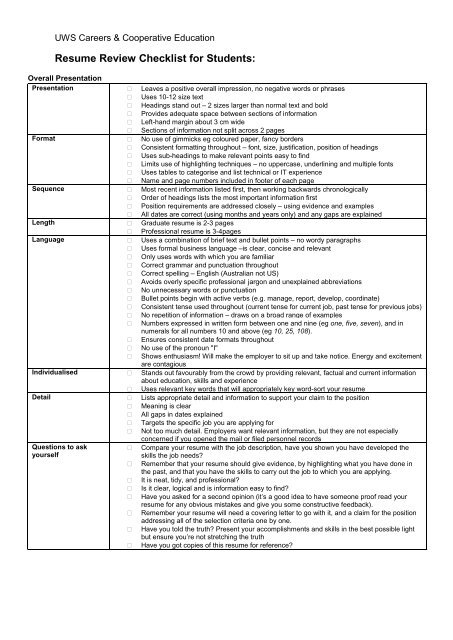
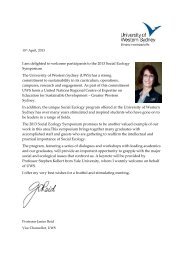
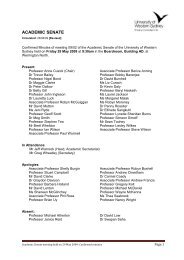
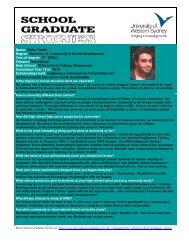
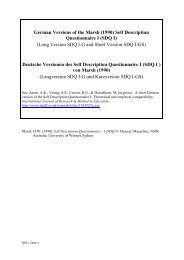
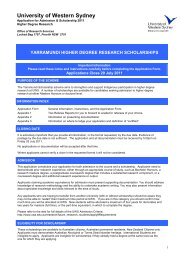

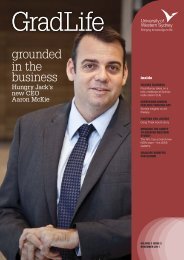
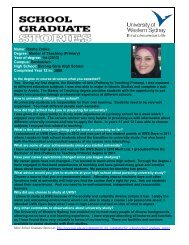
![Glossary of terms for Academic Integration Plans [PDF, 127Kb]](https://img.yumpu.com/46838287/1/184x260/glossary-of-terms-for-academic-integration-plans-pdf-127kb.jpg?quality=85)
